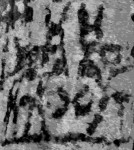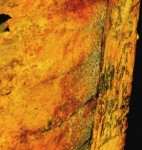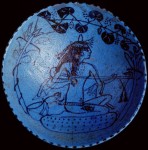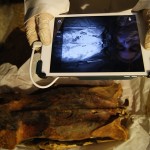 During the Institut Français d’Archéologie Orientale’s 2014-2015 dig at Deir el-Medina, archaeologists found a female mummy with extensive tattoos of animals and flowers. The mummy dates to between 1300 and 1070 B.C., which makes her the first mummy from Dynastic Egypt with non-abstract figural tattoos. Her artwork wouldn’t be out of place in a modern tattoo shop. She has lotus blossoms on her hips, cows on her left arm, baboons on her neck and Wadjet eyes, also known as the Eye of Horus, on her neck, shoulders and back.
During the Institut Français d’Archéologie Orientale’s 2014-2015 dig at Deir el-Medina, archaeologists found a female mummy with extensive tattoos of animals and flowers. The mummy dates to between 1300 and 1070 B.C., which makes her the first mummy from Dynastic Egypt with non-abstract figural tattoos. Her artwork wouldn’t be out of place in a modern tattoo shop. She has lotus blossoms on her hips, cows on her left arm, baboons on her neck and Wadjet eyes, also known as the Eye of Horus, on her neck, shoulders and back.
“Any angle that you look at this woman, you see a pair of divine eyes looking back at you,” says bioarchaeologist Anne Austin of Stanford University in California, who presented the findings last month at a meeting of the American Association of Physical Anthropologists.
Austin noticed the tattoos while examining mummies for the French Institute of Oriental Archaeology, which conducts research at Deir el-Medina, a village once home to the ancient artisans who worked on tombs in the nearby Valley of the Kings. Looking at a headless, armless torso dating from 1300 to 1070 BC, Austin noticed markings on the neck. At first, she thought that they had been painted on, but she soon realized that they were tattoos.
 Aware of studies like the recent multispectral photographic imaging scan that discovered previously unknown tattoos on Ötzi the Iceman, Austin examined the mummy under infrared lighting with an infrared sensor. She found more than 30 tattoos, several of which were on skin that was too darkened by the mummification process for the ink to be seen with the naked eye. Working with Cédric Gobeil, director of the French mission at Deir el-Medina, Austin photographed and digitally reshaped the tattoos to see what they looked like on living flesh, before the skin was shrunk and shriveled by mummification.
Aware of studies like the recent multispectral photographic imaging scan that discovered previously unknown tattoos on Ötzi the Iceman, Austin examined the mummy under infrared lighting with an infrared sensor. She found more than 30 tattoos, several of which were on skin that was too darkened by the mummification process for the ink to be seen with the naked eye. Working with Cédric Gobeil, director of the French mission at Deir el-Medina, Austin photographed and digitally reshaped the tattoos to see what they looked like on living flesh, before the skin was shrunk and shriveled by mummification.
 All of the tattoos are religious symbols. Cows represent the goddess Hathor; the lotus was a symbol of rebirth associated with Osiris; baboons represent Thoth. Wadjet of eye fame was one of the earliest Egyptian deities, later split into various gods including Hathor who, in one version of the mythology, restored Horus’ left eye after Set tore it out. It was a protective symbol against evil. It’s possible that the woman was a priestess, singer and/or musician in the service of Hathor and that the tattoos on the throat and arms were meant to strengthen her performance and connect her to the gods.
All of the tattoos are religious symbols. Cows represent the goddess Hathor; the lotus was a symbol of rebirth associated with Osiris; baboons represent Thoth. Wadjet of eye fame was one of the earliest Egyptian deities, later split into various gods including Hathor who, in one version of the mythology, restored Horus’ left eye after Set tore it out. It was a protective symbol against evil. It’s possible that the woman was a priestess, singer and/or musician in the service of Hathor and that the tattoos on the throat and arms were meant to strengthen her performance and connect her to the gods.
Judging from the degree of fading, the tattoos appear to have been made at different times. This may be an indicator of increasing status in her religious community; the greater the seniority, the more tattoos. Alternatively, they have been her way of expressing her religious fervor, and given how painful the application must have been, it would have demonstrated very great dedication indeed.
 There are no known written records from ancient Egypt that mention tattooing, but there is iconographic evidence in wall paintings and figurines. There’s a faience bowl in the Rijksmuseum van Oudheden in Leiden from around the New Kingdom (1400-1300 B.C.) that depicts a lute player with a pictogram of the god Bes on her thigh and a v-shaped dot grouping on her chest. The Louvre has a piece from the late Middle Kingdom (ca. 2033–1710 B.C.), a faience figurine of a nude woman wearing a belt of cowry shells, her body adorned with groups of dots that may or may not represent tattoos, but are very similar to the dots and dash groupings found on mummies of the period. These kinds of figurines have traditionally been known as Brides of the Dead (this is a misnomer as some were placed in the tombs of women and others weren’t found in tombs at all) and are believed to be guarantors of sexual success and fertility in the next life.
There are no known written records from ancient Egypt that mention tattooing, but there is iconographic evidence in wall paintings and figurines. There’s a faience bowl in the Rijksmuseum van Oudheden in Leiden from around the New Kingdom (1400-1300 B.C.) that depicts a lute player with a pictogram of the god Bes on her thigh and a v-shaped dot grouping on her chest. The Louvre has a piece from the late Middle Kingdom (ca. 2033–1710 B.C.), a faience figurine of a nude woman wearing a belt of cowry shells, her body adorned with groups of dots that may or may not represent tattoos, but are very similar to the dots and dash groupings found on mummies of the period. These kinds of figurines have traditionally been known as Brides of the Dead (this is a misnomer as some were placed in the tombs of women and others weren’t found in tombs at all) and are believed to be guarantors of sexual success and fertility in the next life.
 The earliest Egyptian mummies with identifiable tattoos have the same kind of patterns seen on the Brides. The first examples were unearthed in the late 19th century, most famously at Deir el-Bahari in 1891. French archaeologist Eugène Grébaut discovered the mummy of a woman named Amunet who was a priestess of Hathor in the 11th Dynasty (ca. 2134-1991 B.C.). Her body was tattooed with diamond-shaped patterns of dots on her right thigh, matrices of dots under her sternum and above her navel, and a multiple rows of dots forming an elliptical pattern that covered her abdomen from leg to leg. This tattoo is particularly relevant to fertility because during pregnancy it would have stretched and grown to give the pregnant belly the appearance of being wrapped in a net, likely a protective symbol.
The earliest Egyptian mummies with identifiable tattoos have the same kind of patterns seen on the Brides. The first examples were unearthed in the late 19th century, most famously at Deir el-Bahari in 1891. French archaeologist Eugène Grébaut discovered the mummy of a woman named Amunet who was a priestess of Hathor in the 11th Dynasty (ca. 2134-1991 B.C.). Her body was tattooed with diamond-shaped patterns of dots on her right thigh, matrices of dots under her sternum and above her navel, and a multiple rows of dots forming an elliptical pattern that covered her abdomen from leg to leg. This tattoo is particularly relevant to fertility because during pregnancy it would have stretched and grown to give the pregnant belly the appearance of being wrapped in a net, likely a protective symbol.
 In the New Kingdom, pictographs of the gods were added to the abstract dot and dash patterns. Pictographs of the war goddess Neith have been found on mummies of women dating to around 1300 B.C. Tattoos of Bes, protector of mothers, children and the household, have been found on the thighs of dancers and musicians. Bes danced, sang and made noise to scare away evil spirits, so it’s a reasonable connection. These mummies date to the 4th century B.C. and were the oldest known non-abstract tattoos in Egypt before the recent discovery of the figural tattoos on the mummy from Deir el-Medina.
In the New Kingdom, pictographs of the gods were added to the abstract dot and dash patterns. Pictographs of the war goddess Neith have been found on mummies of women dating to around 1300 B.C. Tattoos of Bes, protector of mothers, children and the household, have been found on the thighs of dancers and musicians. Bes danced, sang and made noise to scare away evil spirits, so it’s a reasonable connection. These mummies date to the 4th century B.C. and were the oldest known non-abstract tattoos in Egypt before the recent discovery of the figural tattoos on the mummy from Deir el-Medina.
 That’s one of the reasons the find is so exciting. Another is that the archaeological record of Egyptian tattoos is patchy at best. Tattoos can be very hard to spot on darkened and wizened mummified flesh, or they can be lost to decay. Besides, we’re no longer in the giddy, reckless days of late 19th century, early 20th century Egyptology when archaeologists loved to unwrap mummies, often in front of crowds. Nowadays mummies are kept wrapped as a matter of course. Technology like CT scanning allow examination in great detail without the invasive and destructive interventions of yesteryear. It can’t read tattoos on the surface of the skin, however, so keeping mummies wrapped makes documenting tattoos impossible.
That’s one of the reasons the find is so exciting. Another is that the archaeological record of Egyptian tattoos is patchy at best. Tattoos can be very hard to spot on darkened and wizened mummified flesh, or they can be lost to decay. Besides, we’re no longer in the giddy, reckless days of late 19th century, early 20th century Egyptology when archaeologists loved to unwrap mummies, often in front of crowds. Nowadays mummies are kept wrapped as a matter of course. Technology like CT scanning allow examination in great detail without the invasive and destructive interventions of yesteryear. It can’t read tattoos on the surface of the skin, however, so keeping mummies wrapped makes documenting tattoos impossible.
With the great success of infrared imaging on the Deir el-Medina mummy, perhaps the large gaps in the record can be at least partially filled by examining mummies that were unwrapped back when that was trendy, or whose wrappings have been lost. All of the Egyptian mummies with tattoos discovered thus far have been female. Was the art form the exclusive province of women, or have we just not found the tattooed men yet? There is artwork that suggests men had tattoos too. A thorough IR analysis of the mummy record may at long last answer the question.
Interesting article. We learn something new each day. Thanks for sharing.
My first thought was that the woman with the flowers and animal tattoos might resemble a woman who comes to my Wool Guild from time to time (she has quite a talented little boy who loves to spin). As I read further, I began to wonder about the underlying culture behind the tattoos. It must have had considerable influence to have become so elaborate and widespread. I am deeply curious, and hope that somehow archaelogists can assemble and analyze evidence that will illuminate what was going on.
Cows – withered or without ’em is the question,
Whether it is noble in the mind to suffer,
The inks and needles of outrageous colors.